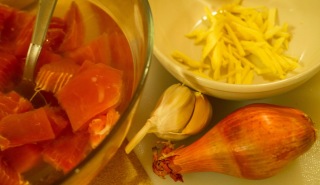The Polynesian diet is very limited because there is hardly anything that grows here other than fruit. We eat about 1 kilo of raw tuna per week on average. Sometimes we eat even more, like on islands where there were no grocery stores. Most of the time, we prepare raw tuna dishes ourselves in the local style. It’s called “poisson cru au lait coco,” which means raw fish with coconut milk.

 Finally, not all “poisson cru” has coconut milk. Poisson cru just means raw fish and there are a lot of different ways to prepare it. Au lait coco is one of the best.
Finally, not all “poisson cru” has coconut milk. Poisson cru just means raw fish and there are a lot of different ways to prepare it. Au lait coco is one of the best.Sunshine's Best Poisson Cru
- Fresh Tuna, about 250g per person
- Fresh Coconut Milk (or, 1/2 can of milk–be sure not to use coconut cream because it is too heavy)
- Shallot (green onion could work well too)
- Ginger (thin-skinned is best)
- Garlic (just a clove or two because it will be raw)
- Carrot
- Tomato
- Cucumber
- 1-2 limes (the small round ones are best)
- Salt
- Prepare a bowl of brine. Place 1-2 heaping tablespoons in a pint of water and adjust for taste. It should taste like sea water.
- Chop the tuna into bite-sized cubes or slices, following the natural grooves on the meat. The shape of the pieces will depend on the cut of tuna.
- Soak the pieces in the brine for at least 10-15 minutes.
- In the meantime, prepare the rest of the ingredients.
- Chop shallot, ginger garlic. You can do them razor-thin or coarse, it doesn’t really matter. Use about 1 shallot, 1 garlic clove, and 1 thumb of ginger for every pound of tuna. Squeeze the juice of one lime over the ginger-onion-garlic.
- Shave the carrots, slice the cucumber, chop the tomato and set aside together.
- Drain the tuna and toss it all together, waiting just a minute or two before adding the coconut milk. The trick is to pour the coconut milk just before the fish changes color from the citric acid.
- Another method is, before you drain the brine, squeeze the juice of one lime on the tuna. Let it marinate until you start to see the color change, less than 5 minutes. Then drain the tuna again before tossing all the ingredients together and adding coconut milk and enjoying.
We learned this from our hosts in Maupiti, who made a scrumptious poisson cru dish we never saw anywhere else. The raw tuna is tossed with sweet soya sauce, lots of ginger, garlic, shallot, and oil (olive or sesame are good). There is probably a quick squeeze of lime for balance but not enough to be detected. This is an unctuous dish.


It's not all that tough to make coconut milk – but it's a pain. You finely grate the coconut meat and then press it to extract the liquid (that or a juicer). I've only done it once and that was enough for a lifetime – you have to grate a lot of coconuts to get a reasonable amount of milk. Great photos and great information – as usual.
LikeLike
I tried once in a different way: cut the coconut in (small) pieces, put in a blender with warm-hot water, blend for a few minutes, then filter.
The water helps getting more milk out.
I haven't really decided if I need to peel the dark skin or not.
LikeLike
I have finally tried pressing my own coconut milk, and although nothing tastes like it, it is a major pain in the ass and very inefficient given the amount of coconut needed to yield just half a cup of the cream. But really, the taste is incomparable.
LikeLike
This comment has been removed by a blog administrator.
LikeLike
Wow–impressive guys! We ultimately did get to try once and it was an incredible amount of work. Like you said Joe, once is enough.
LikeLike